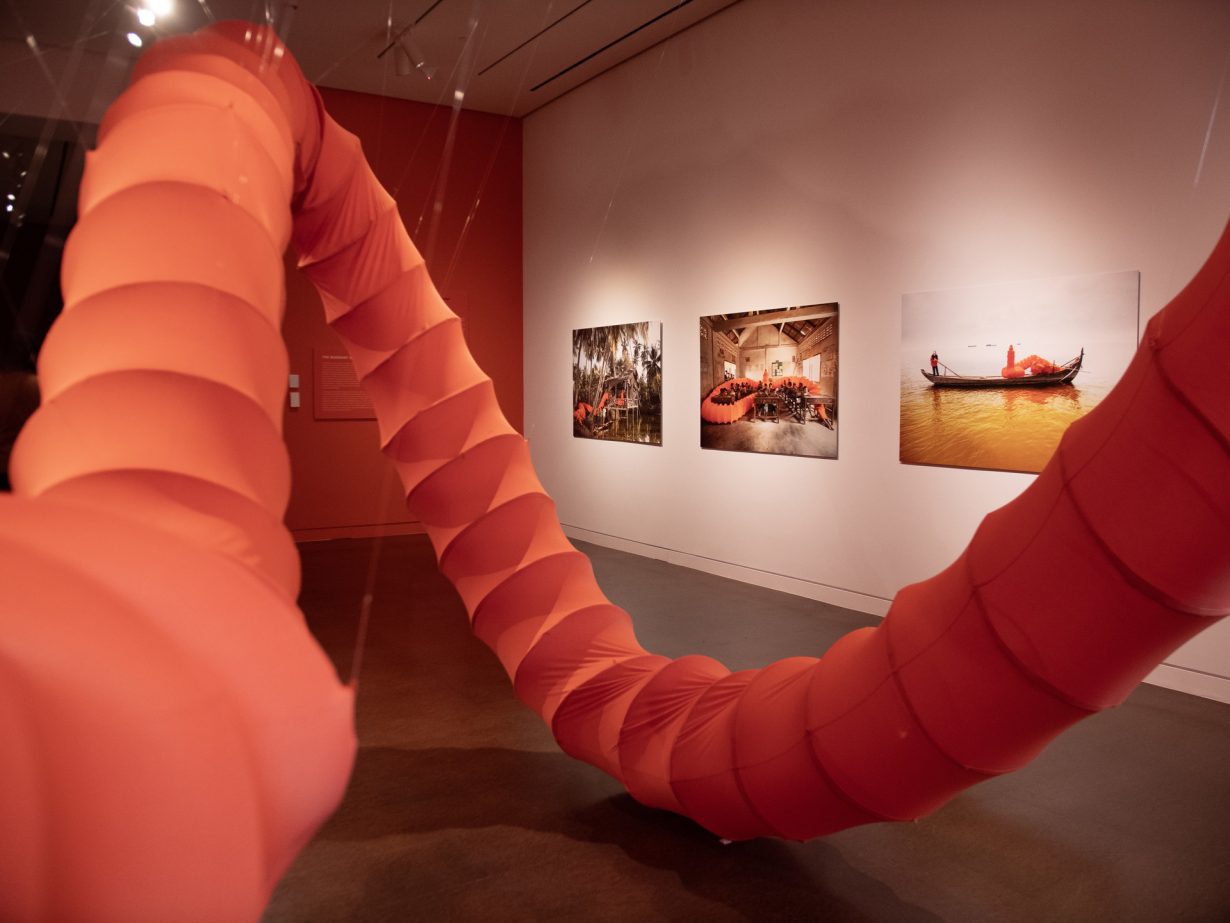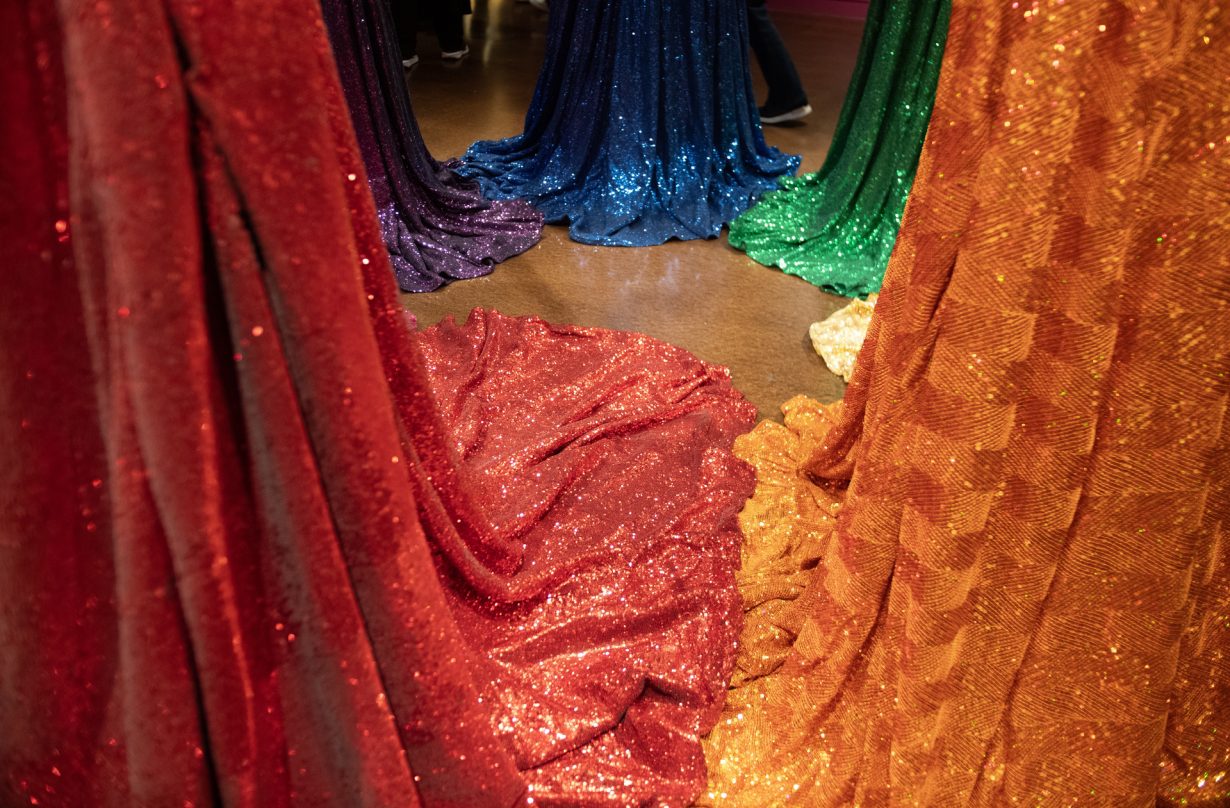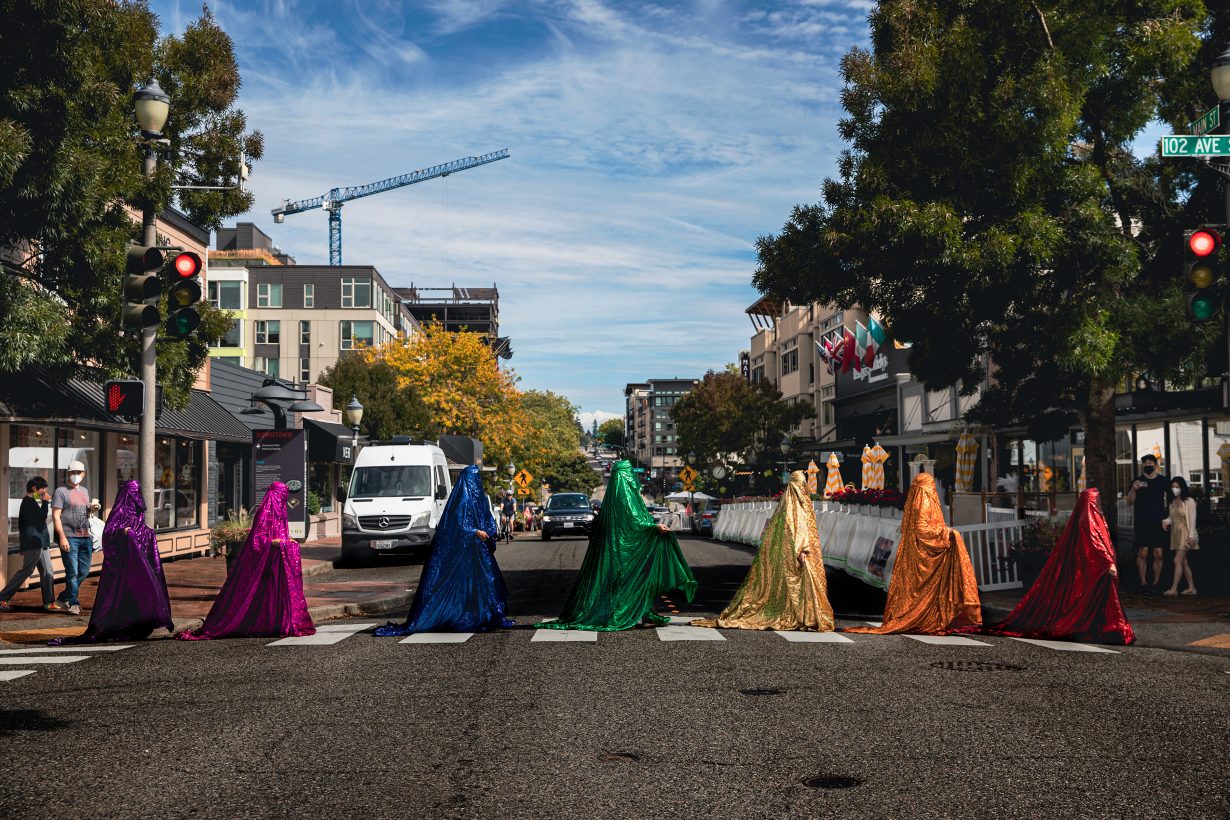Hybrid Skin, Mythical Presence at Seattle Asian Art Museum is a multifaceted response to forms of othering
Pulsing music emanates from within a curtained-off gallery in Anida Yoeu Ali’s exhibition at the Seattle Asian Art Museum. Behind the curtains, the video Genesis 1 (2021) plays. ‘The Red Chador lives and rages on. My existence is an act of protest and defiance because I refuse to disappear,’ a text across the screen reads. The video sets out a mythos for The Red Chador, one of Ali’s performance personas. While a chador, a full-body cloth often worn by Muslim women, is commonly found in darker colours like black or blue, Ali’s is bright and sequinned, both regal and campy. In the film, there is a surreal montage of Ali as The Red Chador emerging from the ocean, and urban scenes of other chador-wearing dancers in a rainbow of colours. Genesis 1 is, in part, provoked by the Cham-Muslim, Cambodia-born artist’s experience with Islamophobia when detained at Tel Aviv airport in 2017, on the way to a conference in Ramallah. She was strip-searched and threatened with deportation; while detained for four hours, border officers repeatedly asked why her last name is Ali; the original Red Chador piece was mysteriously missing from her luggage when she arrived in the US, and never seen again. So in Genesis I The Red Chador, returning as if reborn from one nontraditional bright colour into many, reads as a refusal of oppression through multiplicity.
The exhibition also features The Buddhist Bug, a saffron-orange, accordion-chute garb representing another of Ali’s personas. Curling from the ceiling in a dynamic knot, it acts a visual lynchpin for the central exhibition space, which features mythologies for each of the seven personas (in video and photography by Masahiro Sugano, Ali’s collaborator and husband). The Buddhist Bug’s appearances seem whimsical and playful, perhaps a little like encountering the Caterpillar from Alice’s Adventures in Wonderland: in the photo Spiral Alley (2013), the thirty-meter garb winds up a spiral stairwell; in another photo, Around Town, The Buddhist Bug (2012), it engulfs a three-wheel cart – the driver stares at the feet dangling out of one end of the accordion-chute, while Ali’s face points determinedly forward from the front. There are photos of The Red Chador’s first performance, in 2015 at Paris’s Palais de Tokyo where, in an at once humorous and deadly serious commentary on Islamophobia and colonisation, the character threatened to execute a baguette every hour. Ali’s work draws on her own cultural background – Cham is a layered, multilingual identity with Buddhist, Hindu, and Muslim influences, spread across the national borders between Malaysia, Thailand, Vietnam and Cambodia – while also looking to confront and subvert stereotypes of Southeast Asian communities. As such, her performance personas are a multifaceted response to forms of othering: at once looking to add nuance to an American audience’s understanding of her origins, whose common first reference to her world might well be the 1975–79 Cambodian Genocide under the Khmer Rouge, while also opening up space in which to critique misogyny and anti-LGBTQIA+ sentiments within the Muslim community.


Based in the adjoining city of Tacoma, Ali is surely aware of the ways in which Seattle’s intricate overlap of cultures and spiritual communities nonetheless often remain segregated from more central, monied and white neighbourhoods. In February of this year in Seattle, a Muslim woman was assaulted at knifepoint, her hijab forcibly removed in a suspected hate crime. Throughout the United States, during the current Israel–Hamas conflict, reports of anti-Muslim attacks have increased. Before the opening of the exhibition, Ali’s professional website was hacked and she received personal and anti-Muslim threats via social media. It is in this environment that in early June Ali held her latest performance, The Red Chador (Afterlife) (2024), a daylong procession through key landmarks of downtown Seattle. Beginning at the Seattle Asian Art Museum in Volunteer Park, the performance travelled through the Westlake Center mall to the city’s iconic Space Needle, then through the Olympia Sculpture Park, along the downtown waterfront and finally to the Seattle Art Museum.
On the day of the procession the chador-draped performers, each wearing sparkling red, pink, orange, green, blue and gold, are greeted in the gallery space by nearly 50 spectators. Each performer gestures silently to welcome those who are willing to interact. Never speaking, they extend their henna-covered hands from their hearts as an offering of connectedness, bowing at times. The Chadors exit the museum into the silvery light of a grey day. They march through Volunteer Park, initially hesitant but then reassured by the eagerness with which strangers setting up for the day’s simultaneous Pride celebrations interact with them. At Westlake Mall, the performers meet an unsuspecting crowd; members of the mall security seem stunned as the Chadors pass through Saks Fifth Avenue, but begin to bemusedly take photos with their phones. I and other followers board a train with them to the Space Needle. As the Chadors lovingly adjust each other’s veils, I wonder if those who are witnessing the procession can read beyond a clear rainbow-coloured queering Muslim representation; if all the levels of Ali’s intentions translate.
The colours of the Chadors echo the opening Pride celebrations (it is intentional that The Red Chador [Afterlife] is taking place on the first day of Pride). The exhibition’s curator, José Carlos Diaz, circulates the crowd, his museum lanyard swinging around his chest. Although immaculately planned, there are no permits for this procession. In the first leg of the performance, the Chadors are at times just as tentative in their physical greetings as those witnessing the event. But with the growing number of enthusiastic followers, the tone shifts to a general energy of calm and appreciation. When the Chadors appear at the park at the foot of the Space Needle, children playing nearby point and yell joyfully, reacting as if some kind of magical event is taking place. Some parents bring their children closer; the purple Chador pushes the orange Chador on a swing. There are also parents who pull their children away; the Chador in red receives a shoulder check; the spectators crowd in around the performer. Later, at the Olympic Sculpture Park, as the Chadors pass through the iron frozen waves of Richard Serra’s sculpture Wake (2004), someone I cannot see yells, “Free, Free Palestine!” The Chadors and a few others raise their fists in a signal of recognition. Some spectators clap and cheer in support.

In action, the wide aperture of the performance apparently has the effect of bringing people closer. Between the Olympic Sculpture Park and the seafront stretch of road along Piers 70 through 60, the followers grow to around a hundred people. They flank the procession, making a corridor around the walking Chadors. They block the street as the stop light turns from red to green, holding up a few cars and a tour bus, where tourists run to the rails to photograph the event. The rainbow line of Chadors crossing the street is unmissably Beatles-esque, the crowd seemingly enamoured with this unlikely slippage into pop culture.
The final stop is the Seattle Art Museum. After processing through the galleries, the Chadors sit on the floor in a circle in the main lobby, then they remove their veils to reveal relieved and appreciative smiles. The overall aura is exhaustion and satisfaction. While sitting among Chadors, the remaining audience members speak of feeling inspired, and of having learned about the connection between Ali’s perspective and the contemporary moment. The method of Ali’s performance could be said to match that of her own lived experience: different realities, no matter how irreconcilable they seem, are understood as cocreated.
Hybrid Skin, Mythical Presence at Seattle Asian Art Museum, through 7 July
